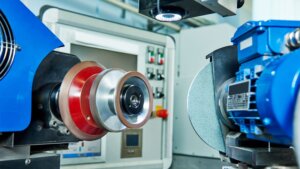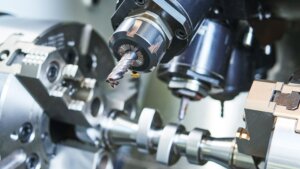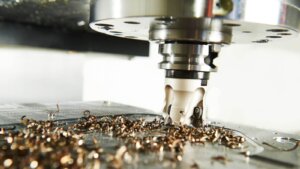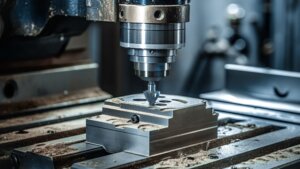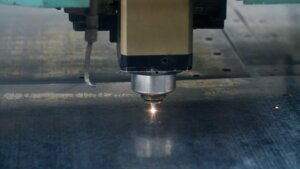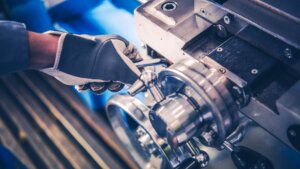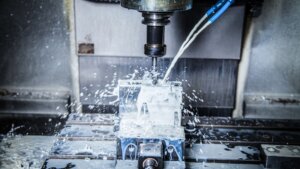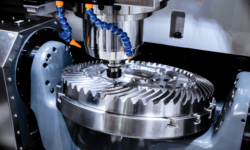Machine tools are the foundation of modern manufacturing, offering precision, power, and unparalleled versatility in shaping materials.
This guide goes deep into the world of machine tools, unraveling their significance, evolution, and the technological advancements that have shaped today’s industry.
What Is a Machine Tool?
A machine tool, a critical component in the machining process, is a power-driven device designed to shape or fabricate materials, typically metal, by cutting, boring, grinding, shearing, or other forms of deformation. These tools range from simple hand tools like screw-cutting lathes to highly sophisticated CNC machines, which use computer numerical control for precision machining.
The Importance of Machine Tools
At their core, machine tools are about transformation. They remove material to create parts with precise shapes and sizes, essential in industries from automotive to aerospace. Their capacity to produce components with high precision and speed not only increases efficiency but also pushes the boundaries of innovation in manufacturing.
Every modern machine shop will have several machine tool types and people trained in how to use them.
How Has the Concept of Machine Tools Evolved Over Time?
The history of machine tools is a fascinating journey through time, marked by significant milestones that revolutionized manufacturing processes. Each era brought new developments, shaping the tools and techniques we use today.
3,000 BC: Introduction of the Lathe in Ancient Egypt
The origins of machine tools trace back to ancient civilizations, with the Egyptians introducing the lathe, a pivotal moment in machining history. This early invention laid the groundwork for subsequent developments in machine tool technology.
Middle Ages: Emergence of the Windmill and Waterwheel – Pioneers of Mechanical Power
In the Middle Ages, the advent of windmills and waterwheels marked a significant shift. These early examples of machine tools harnessed natural forces, introducing mechanical power into the manufacturing realm.
18th Century: Steam Power Ushers in a New Era
The 18th century heralded the age of steam power, a major turning point. The steam engine, an iconic symbol of the Industrial Revolution, propelled machine tools into a new era of productivity and efficiency.
Late 19th to Early 20th Century: The Electrification of Machine Tools
Electrification in the late 19th and early 20th centuries brought another transformative phase. The introduction of electric motors in machine tools led to increased power and control, paving the way for more complex and precise machining operations.
1960s: Dawn of the Digital Age – CNC Takes Center Stage
The 1960s marked the beginning of the digital age in machine tool history. The emergence of CNC machining revolutionized the field, introducing unprecedented levels of precision and automation.
What Are Key Nomenclature and Concepts Related to Machine Tools?
Machine tools, an integral part of the manufacturing landscape, are steeped in a lexicon that’s as diverse as their applications. Understanding these terms not only enriches one’s knowledge but also enhances comprehension of the manufacturing process.
Key Terminologies in the Realm of Machine Tools:
- Tolerance: machining tolerances refer to the allowable limit of variation in a physical dimension. In machining, tolerance is critical as it dictates how much deviation from the specified dimensions is acceptable.
- Feed Rate: the speed at which a cutting tool moves through the material being machined. It’s an important parameter in determining the quality of the cut and the efficiency of the machining process.
- Surface Finish: describes the texture of the surface of a machined part. Surface finish is important for both aesthetic and functional reasons, as it can affect the performance and longevity of the part.
- Tool Wear: The gradual breakdown and loss of material from a cutting tool due to regular use. Understanding and managing tool wear is crucial for maintaining the quality and precision of machining operations.
- Spindle Speed: The rate at which the spindle of a machine tool rotates. This speed impacts the cutting process, influencing factors like the rate of material removal and the quality of the finished surface.
- Coolant and Lubrication: These are fluids used in machining to reduce friction and heat, which can damage both the tool and the workpiece. Proper use of coolants and lubricants can extend tool life and improve the quality of machining.
- Chip Formation: Refers to the process of removing material from a workpiece during machining. The characteristics of chip formation can impact the efficiency of the cutting process and the quality of the finished product.
- Machinability: Machinability describes how easily a material can be machined. Factors influencing machinability include the material’s hardness, ductility, and thermal conductivity.
- Jig and Fixture: Jig and fixtures are tools used to hold, support, and locate a workpiece during a machining operation. They are essential for ensuring precision and repeatability in machining processes.
- Programmable Logic Controller (PLC): A digital computer used for automation of electromechanical processes in machine tools. PLCs are critical in CNC machines for precise control of the machining operations.
- Axis of Motion: In machine tools, this refers to the direction in which the tool or workpiece can move. The number of axes (such as 3-axis, 5-axis) determines the complexity and capability of the machining operation.
- Material Removal Rate (MRR): This is a measure of the rate at which material is removed from a workpiece during machining. It’s an important factor for efficiency and productivity in manufacturing processes.
What Powers Machine Tools?
The heart of any machine tool is its power source, an element as crucial as the tool itself. Diverse power sources have driven the evolution of machine tools, each bringing a unique set of capabilities and efficiencies.
- Manual Power: Rooted in history, manual power relies on human effort. Simple hand tools, like the screw cutting lathe, still find their place in modern workshops, exemplifying the enduring value of manual skills.
- Mechanical Power: The introduction of mechanical power through steam engines marked a revolution. These early power sources transformed the capabilities of machine tools, enabling more significant, labor-intensive tasks to be completed with ease.
- Electricity: The electrification of machine tools, with the advent of the electric motor, brought about a new era of precision and efficiency. Electric power drives a multitude of machine tools today, from milling machines to drilling machines, offering consistent and controllable power.
- Computer Numerical Control (CNC): In the realm of modern manufacturing, CNC machines stand out. These sophisticated tools use computer systems for control, executing complex machining processes with unparalleled precision. CNC technology represents the pinnacle of machine tool automation, leveraging computer-aided design (CAD) and manufacturing processes to produce intricate and precise metal components.
- Hybrid Systems: Today’s machine tools often combine various power sources, integrating manual inputs with advanced computerized control systems. This synergy allows for greater flexibility and adaptability in the manufacturing process.
Can Machine Tools Function Automatically?
The concept of automation in machine tools has been a game-changer, significantly altering the manufacturing landscape.
- Early Mechanical Systems: Initially, machine tools utilized simple mechanical systems for automation, such as cams and gear systems, to perform repetitive tasks.
- Electrification: With the advent of electric motors, machine tools gained the ability to operate more consistently and with greater precision, paving the way for more advanced automated functions.
- Numerical Control (NC): The development of NC machines introduced the concept of programmed control, allowing machine tools to execute predefined operations with high accuracy.
- Computer Numerical Control (CNC): The introduction of CNC machines marked a revolutionary step in automation. These machines, powered by digital technology, offer unmatched precision and complexity in machining processes.
- Advanced Automation with CAD/CAM Integration: The integration of CNC machines with CAD/CAM software has further enhanced their capabilities, enabling the automated production of highly intricate designs.
- Smart Manufacturing and IoT: The latest development in automation involves the integration of machine tools with the Internet of Things (IoT) and smart manufacturing systems. This integration allows for real-time monitoring, predictive maintenance, and even autonomous decision-making in some cases.
What Are the Main Characteristics of Machine Tools?
Machine tools are distinct entities in the world of machinery, characterized by features that set them apart. These characteristics not only define their functionality but also their versatility in various manufacturing processes.
- Precision and Accuracy: Machine tools, especially CNC machines, are renowned for their ability to produce parts with high precision and accuracy. This is crucial in industries where even minute deviations can have significant implications.
- Versatility: From milling machines to lathes, machine tools can perform a multitude of tasks like cutting, shaping, and drilling, making them indispensable in manufacturing.
- Power-Driven Operation: Most modern machine tools are power-driven, using sources like electricity and computer numerical control (CNC) for enhanced efficiency and control.
- Material Removal Process: A fundamental characteristic of machine tools is their ability to remove material from a workpiece, shaping it into the desired form through processes like milling, turning, and drilling.
- Rigidity and Stability: Machine tools are designed to withstand the stresses of manufacturing processes, ensuring rigidity and stability to maintain accuracy over time.
- Speed and Efficiency: The automation and technological advancements in machine tools, such as CNC machining, allow for faster production times without compromising on quality.
- Customization and Adaptability: Modern machine tools can be customized and adapted for a range of tasks, supported by advancements in computer-aided design (CAD) and manufacturing (CAM) technologies.
What Are the Types of Cutting Tools Used in Machine Tools?
Cutting tools are the workhorses of machine tools, each type designed for specific operations. Understanding these tools is key to grasping the capabilities of different machine tools.
- Milling Cutters: Used in milling machines, these tools come in various shapes and sizes for operations like end milling, face milling, and profile milling.
- Drill Bits: Essential for drilling machines, drill bits create holes in materials. Variants include twist drills, center drills, and indexable drills.
- Lathe Tools: Used in lathes for operations like turning, facing, and threading. These include tool bits and insert tools for precision work.
- Boring Tools: Designed for enlarging holes, boring tools are used in boring machines and lathes for precise hole-making.
- Screw Cutting Tools: These are specialized tools used in screw cutting lathes for creating screw threads.
- Broaches: Used in broaching machines, these tools are designed for precision cutting applications, particularly in shaping internal and external surfaces.
- Reamers: Employed for finishing operations, reamers are used to improve the finish and size of drilled holes.
What Are the Most Common Types of Machine Tools?
Machine tools, integral to the manufacturing process, come in various forms, each tailored for specific functions and operations. Let’s delve into some of the most common types.
Turning Machines
A turning machines, better known as lathe, are used for machining rotary parts. They remove material from a workpiece by rotating it against a cutting tool.
Common Applications:
- Creating cylindrical parts
- Cutting screw threads
- Drilling and boring holes
- Producing symmetrical objects
Price Range: $5,000 – $50,000 USD Lifespan: 10 – 20 years
Tooling and Accessories:
- Cutting tools for different materials
- Chuck for holding the workpiece
- Tailstock for additional support
- Specialized tools for threading and finishing
Accuracy and Tolerance:
- Can achieve tolerances within 0.01mm – 0.05mm
Shapers
Shapers are used for cutting flat surfaces, grooves, and contours using a linear back and forth motion of the cutting tool against a stationary workpiece.
Common Applications:
- Cutting internal and external gears
- Creating keyways and slots
- Shaping flat metal surfaces
Price Range: $1,000 – $10,000 USD Lifespan: 5 – 15 years
Tooling and Accessories:
- Variety of cutting tools for different shapes
- Clamps and vices for workpiece stability
- Jigs and fixtures for precision shaping
Accuracy and Tolerance:
- Tolerance ranges from 0.01mm to 0.1mm
Planers
Planers are used for producing flat and angular surfaces, where the workpiece moves linearly against a stationary cutting tool.
Common Applications:
- Machining large surfaces
- Shaping steel plates
- Finishing metal molds
Price Range: $10,000 – $100,000 USD Lifespan: 10 – 25 years
Tooling and Accessories:
- Specialized cutting heads for various materials
- Magnetic or hydraulic clamping systems
- Custom jigs for complex shapes
Accuracy and Tolerance:
- Capable of achieving tolerances within 0.01mm – 0.05mm
Drilling Machines
Drilling machines, designed for creating holes in materials, employ a rotating drill bit that exerts a force on the workpiece to create a hole.
Common Applications:
- Drilling holes in metal, wood, and plastics
- Creating holes for screws and bolts
- Boring holes for larger diameters
Price Range: $500 – $20,000 USD Lifespan: 5 – 15 years
Tooling and Accessories:
- Various drill bits for different materials
- Clamps and vices for workpiece stability
- Specialized attachments for angle drilling
Accuracy and Tolerance:
- Typically can achieve tolerances within 0.05mm – 0.5mm
Gang Drills
Gang drills consist of a group of drill heads mounted on a single table, allowing multiple holes to be drilled simultaneously.
Common Applications:
- Mass production of parts with multiple drilling requirements
- Efficient drilling in assembly line manufacturing
Price Range: $1,000 – $30,000 USD Lifespan: 10 – 20 years
Tooling and Accessories:
- Multiple drill heads for varied operations
- Automated feed mechanisms
- Customizable setups for specific projects
Accuracy and Tolerance:
- Capable of achieving tolerances within 0.1mm – 0.5mm
Milling Machines
A milling machine uses rotary cutters to remove material from a workpiece, advancing in a direction at an angle with the axis of the tool.
Common Applications:
- Creating slots, grooves, and irregular surfaces
- Complex part manufacturing like gears and threads
Price Range: $2,000 – $60,000 USD Lifespan: 10 – 25 years
Tooling and Accessories:
- A variety of milling cutters for different operations
- Precision vises and clamps for workpiece stability
- Rotary tables and dividing heads for complex milling operations
Accuracy and Tolerance:
- Tolerance ranges from 0.01mm to 0.1mm
Machining Centers
A machining center is an advanced CNC machine capable of a variety of machining operations and processes, integrating multiple tools into a single unit.
Common Applications:
- High-precision manufacturing of complex parts
- Automotive and aerospace component production
- Intricate mold and die making
Price Range: $20,000 – $150,000 USD
Lifespan: 10 – 30 years
Tooling and Accessories:
- Automated tool changers
- High-speed spindles for precise machining
- Advanced software for CAD/CAM integration
Accuracy and Tolerance:
- High precision with tolerances as tight as 0.005mm – 0.01mm
Production Millers
Production millers, specialized in high-volume milling, are designed for efficiency and consistency in producing large quantities of similar parts.
Common Applications:
- Mass production of automotive parts
- Milling operations in heavy industries
- High-speed machining for electronics and consumer goods
Price Range: $15,000 – $80,000 USD Lifespan: 10 – 20 years
Tooling and Accessories:
- Various milling cutters for different materials
- Automated tool changers for efficient operation
- High-precision vises and fixtures
Accuracy and Tolerance:
- Capable of achieving tolerances within 0.01mm – 0.05mm
Grinding Machines
A grinding machine use abrasive wheels to finish workpieces by removing material to achieve a smooth surface or to form specific shapes.
Common Applications:
- Sharpening cutting tools
- Finishing metal parts to precise dimensions
- Surface finishing in tool and die making
Price Range: $2,000 – $50,000 USD Lifespan: 5 – 15 years
Tooling and Accessories:
- Different grinding wheels for various materials
- Coolant systems to reduce heat
- Precision dressers for wheel maintenance
Accuracy and Tolerance:
- Grinding machines can achieve tolerances as tight as 0.001mm – 0.01mm
Power Saws
Power saws are used to cut materials like metal, wood, and plastic, utilizing a toothed blade or disk.
Common Applications:
- Cutting metal bars and tubes
- Trimming excess material from castings
- Making straight or curved cuts in woodworking
Price Range: $500 – $20,000 USD Lifespan: 5 – 10 years
Tooling and Accessories:
- Various blades for different materials
- Guides and fences for precision cutting
- Dust collection systems for cleanliness
Accuracy and Tolerance:
- Generally, tolerances range from 0.1mm to 1mm, depending on the material and type of saw
Presses
Presses are machine tools that shape or cut materials by applying compressive force. They come in various forms, including mechanical, hydraulic, and pneumatic.
Common Applications:
- Forming and shaping metal sheets
- Punching and cutting operations
- Pressing bearings and assembling components
Price Range: $3,000 – $100,000 USD Lifespan: 10 – 30 years
Tooling and Accessories:
- Dies and molds for shaping
- Punch sets for cutting operations
- Protective guards and automated feeding systems
Accuracy and Tolerance:
- Can achieve tolerances ranging from 0.05mm to 0.5mm
Broaching Machines
Broaching machines use a toothed tool, called a broach, to remove material. They are known for precision machining of complex shapes.
Common Applications:
- Creating unique profiles and keyways
- Machining splines and gear teeth
- Producing high-precision slots and holes
Price Range: $15,000 – $50,000 USD Lifespan: 5 – 15 years
Tooling and Accessories:
- A variety of broaches for different shapes
- Clamping fixtures for securing workpieces
- Lubrication systems for smoother operations
Accuracy and Tolerance:
- Capable of achieving tolerances as tight as 0.01mm – 0.1mm
Lapping Machines
Lapping machines are used to produce highly smooth and polished surfaces through a slow, gentle rubbing process.
Common Applications:
- Finishing high-precision parts
- Creating mirror-like surfaces on metals
- Achieving extreme flatness on surfaces
Price Range: $1,000 – $20,000 USD Lifespan: 10 – 20 years
Tooling and Accessories:
- Lapping plates and slurry for different materials
- Conditioning rings for maintaining plate flatness
- Measuring instruments for surface finish
Accuracy and Tolerance:
- Can achieve surface finishes with tolerances up to 0.001mm
Honing Machines
Honing machines use abrasive stones for precision surface finishing, primarily in cylinder bores or other cylindrical surfaces.
Common Applications:
- Finishing internal surfaces of cylinders
- Smoothing and sizing hydraulic tubes
- Surface refinement in engine components
Price Range: $5,000 – $30,000 USD Lifespan: 10 – 20 years
Tooling and Accessories:
- Various honing stones for different materials
- Mandrels for stabilizing the honing process
- Coolant systems for heat and debris management
Accuracy and Tolerance:
- Can achieve surface finishes with tolerances as precise as 0.01mm – 0.05mm
Gear-Cutting Machines
Gear-cutting machines are specialized tools designed for creating precise gears, sprockets, and splines.
Common Applications:
- Manufacturing various types of gears like spur, helical, and bevel gears
- Producing gears for automotive transmissions
- Crafting sprockets for machinery and bicycles
Price Range: $20,000 – $100,000 USD Lifespan: 10 – 25 years
Tooling and Accessories:
- Different cutters for various gear types
- Clamping fixtures for secure gear placement
- Deburring tools for finishing gear teeth
Accuracy and Tolerance:
- Typically achieves tolerances within 0.01mm – 0.1mm
Special-Purpose Machines
Special-purpose machines are designed for specific tasks, often custom-built for unique manufacturing processes.
Common Applications:
- Automotive part production like pistons and connecting rods
- Aerospace component machining
- Custom fabrication for unique industrial applications
Price Range: Varies widely based on customization, generally $50,000 – $500,000 USD Lifespan: Varies based on usage and maintenance, typically 10 – 20 years
Tooling and Accessories:
- Customized tooling for specific production tasks
- Automated loading and unloading systems
- Precision measurement and control systems
Accuracy and Tolerance:
- Can vary, but often designed to achieve very high precision, sometimes up to 0.005mm
Boring Machines
Boring machines are used for enlarging and finishing holes to precise dimensions and surface finishes.
Common Applications:
- Machining engine cylinders and gun barrels
- Precision boring in aerospace and automotive industries
- Creating precise holes in heavy-duty industrial machinery
Price Range: $10,000 – $100,000 USD Lifespan: 10 – 20 years
Tooling and Accessories:
- Various boring bars and heads for different sizes
- Stabilizing and alignment fixtures
- Digital measuring systems for accuracy
Accuracy and Tolerance:
- Capable of achieving tolerances within 0.01mm – 0.05mm
Laser Cutting Machines
Laser cutting machines use high-powered lasers to cut or engrave materials with precision.
Common Applications:
- Cutting sheet metal for automotive and aerospace components
- Engraving designs on wood, glass, and plastics
- Fabricating intricate parts for electronics
Price Range: $15,000 – $300,000 USD Lifespan: 5 – 15 years
Tooling and Accessories:
- Different lenses and nozzles for various cutting tasks
- Automated material handling systems
- Cooling and exhaust systems for heat management
Accuracy and Tolerance:
- High precision, often achieving tolerances as tight as 0.005mm – 0.01mm
Water Jet Cutting Machines
Water jet cutting machines use a high-pressure stream of water, often mixed with abrasive materials, to cut a wide range of materials.
Common Applications:
- Cutting metals, glass, and stone without heat distortion
- Shaping intricate designs in materials like marble and wood
- Fabricating automotive and aerospace components
Price Range: $30,000 – $200,000 USD Lifespan: 5 – 15 years
Tooling and Accessories:
- Abrasive materials for enhanced cutting
- Specialized nozzles for different cutting intensities
- Advanced software for precise control of the cutting process
Accuracy and Tolerance:
- Can achieve tolerances within 0.1mm – 0.25mm
Welding Machines
Welding machines are used to join materials, typically metals or thermoplastics, by melting the base material and adding a filler material.
Common Applications:
- Fabricating metal structures like buildings and bridges
- Joining pipes and tubes in the oil and gas industry
- Automotive and shipbuilding industries
Price Range: $500 – $20,000 USD Lifespan: 5 – 10 years
Tooling and Accessories:
- Various welding electrodes and wires
- Protective gear for safe operation
- Automated feeders for consistent welding
Accuracy and Tolerance:
- Depends on the welding technique; some advanced methods achieve high precision
Screw Machines
Screw machines are a type of lathe primarily used for precise and repetitive production of turned parts and fasteners.
Common Applications:
- Producing screws, bolts, and other fasteners
- High-volume manufacturing of intricate parts
- Components for electronics and medical devices
Price Range: $10,000 – $60,000 USD Lifespan: 10 – 20 years
Tooling and Accessories:
- Multiple cutting tools for various operations
- Collets and chucks for holding workpieces
- Bar feeders for continuous operation
Accuracy and Tolerance:
- Can achieve tolerances within 0.01mm – 0.05mm
Jig Boring Machine
Jig boring machines are high-precision machines used for enlarging holes and finishing them with extreme accuracy.
Common Applications:
- Creating precise holes in aerospace components
- High-precision boring in automotive parts
- Tool and die making
Price Range: $50,000 – $200,000 USD Lifespan: 10 – 20 years
Tooling and Accessories:
- Precision boring heads and tools
- Jigs and fixtures for accurate positioning
- Digital measuring systems for enhanced accuracy
Accuracy and Tolerance:
- Capable of achieving tolerances within 0.005mm – 0.01mm
Slotting Machine
Slotting machines, also known as slotter, are used for cutting slots, keyways, and grooves in materials.
Common Applications:
- Cutting internal gears and keyways
- Slotting grooves in machine parts
- Forming or cutting materials in workshops
Price Range: $10,000 – $60,000 USD Lifespan: 10 – 15 years
Tooling and Accessories:
- Various cutting tools for different slot sizes
- Clamping fixtures for secure positioning
- Lubrication systems for smoother operations
Accuracy and Tolerance:
- Generally achieves tolerances of 0.1mm – 0.5mm
Tapping and Threading Machines
Tapping and threading machines are used for creating internal threads in holes for screws or bolts.
Common Applications:
- Threading operations in metalworking
- Creating threads in plastic components
- Automotive and machinery part production
Price Range: $3,000 – $20,000 USD Lifespan: 5 – 10 years
Tooling and Accessories:
- Taps and dies of various sizes and threads
- Lubrication systems for effective threading
- Clamps and holders for stable operation
Accuracy and Tolerance:
- Typically, tolerances range from 0.05mm – 0.1mm
What Are the Types of Cutting Tools Used in Machine Tools?
Understanding the different types of cutting tools used in machine tools is crucial for anyone involved in the manufacturing process. These tools are integral in shaping and fabricating materials to meet precise specifications. Let’s delve into the various cutting tools and their specific purposes.
Single-Point Cutting Tools
Single-point cutting tools are used in lathes, shapers, and planers. They have a single cutting edge that removes material from the workpiece.
- Examples: Lathe tools, planer tools
- Applications: Turning, shaping, planing
- Materials Cut: Metals, plastics, wood
- Key Features: High precision, customizable for specific tasks
Multi-Point Cutting Tools
Multi-point cutting tools are designed with multiple cutting edges that work simultaneously, increasing the efficiency of the machining process.
- Examples: Milling cutters, drills, broaches
- Applications: Milling, drilling, broaching
- Materials Cut: Metals, alloys, composites
- Key Features: Versatility, high-speed operation, suitable for complex shapes
Abrasive Cutting Tools
These tools use abrasive materials to remove material from the workpiece. They are essential for finishing operations to achieve a smooth surface.
- Examples: Grinding wheels, abrasive belts
- Applications: Grinding, polishing, honing
- Materials Cut: Hard metals, ceramics, glass
- Key Features: High surface finish, precision in dimension and shape
Indexable Cutting Tools
Indexable tools have replaceable cutting inserts. They are practical for operations requiring frequent tool changes due to wear or damage.
- Examples: Indexable drills, milling cutters
- Applications: General milling, drilling
- Materials Cut: Wide range, including metals and plastics
- Key Features: Easy maintenance, cost-effective, adaptable for various tasks
Solid Cutting Tools
Solid cutting tools are crafted from a single piece of material. They are commonly used for specialized tasks and high-precision work.
- Examples: Solid carbide drills, end mills
- Applications: Precision drilling, end milling
- Materials Cut: Metals, especially hard-to-machine alloys
- Key Features: High rigidity, excellent wear resistance
Custom and Specialized Tools
Customized tools are designed for specific applications, particularly where standard tools cannot meet the unique requirements of the workpiece or process.
- Examples: Form cutters, thread mills
- Applications: Custom milling, threading
- Materials Cut: Specific to application
- Key Features: Tailored to unique operations, highly precise
What Benefits Do Machine Tools Bring to Manufacturing and Industry?
Machine tools, being the backbone of manufacturing, offer a plethora of benefits, ranging from improving production efficiency to enhancing product quality. Below are some of the key advantages, including both well-known and some less obvious but equally significant benefits.
- Increased Production Speed: Machine tools, especially CNC machines, expedite the manufacturing process, enabling rapid production of parts.
- Enhanced Precision and Consistency: They deliver high precision in manufacturing, crucial for industries like aerospace and medical devices.
- Versatility in Operations: Capable of performing multiple tasks like cutting, drilling, and shaping, they eliminate the need for multiple specialized machines.
- Reduced Labor Costs: Automation of machine tools reduces the reliance on manual labor, thereby cutting down labor costs.
- Improved Safety: Minimizes the risk of accidents as most operations are automated and enclosed.
- Flexibility in Design: CNC machining allows for easy adjustments in design without the need for new tools or equipment.
- Optimized Material Utilization: Advanced machine tools minimize waste by optimizing material usage during the manufacturing process.
- Conservation of Energy: Modern machine tools are designed for energy efficiency, reducing the overall energy consumption in manufacturing units.
- Longevity and Durability of Tools: High-quality machine tools are durable and have a long service life, ensuring long-term return on investment.
- Integration with Modern Technologies: Compatibility with technologies like IoT and AI for enhanced productivity and predictive maintenance.
- Facilitation of Complex Machining: They allow for complex and intricate machining processes which are impossible to achieve manually.
- Customization and Tailoring: Enable the production of customized and tailored products according to specific customer requirements.
- Reduced Turnaround Time: Enhances the ability to meet tight deadlines due to faster production capabilities.
- Scalability of Production: Machine tools make it easier to scale production up or down based on demand fluctuations.
- Quality Control and Assurance: They ensure consistent quality, crucial for maintaining standards and compliance in various industries.
What Are the Uses and Applications of Machine Tools?
Machine tools play a critical role in various industries by shaping and fabricating materials. Let’s explore how different sectors utilize these tools to meet their unique manufacturing needs.
Aerospace Industry
- Precision Parts Creation: CNC machines craft complex components like turbine blades.
- Material Versatility: Used for metals like titanium and composites essential in aerospace.
- High Tolerance: Ensures parts meet stringent safety and performance standards.
Automotive Industry
- Mass Production: Machine tools like milling machines and lathes produce engine components and chassis parts efficiently.
- Customization and Flexibility: CNC machining caters to varying designs and models.
- Quality Control: Consistent precision crucial for automotive reliability.
Metalworking
- Shaping and Cutting: Lathes, milling machines, and drills shape metal parts for various applications.
- Fabrication: Machine tools assist in creating structures, from simple brackets to complex machinery parts.
- Tool Making: Essential in manufacturing tools for other industries.
Electronics
- Circuit Board Manufacturing: Precision machining for creating detailed circuit boards.
- Component Housing: Producing enclosures for electronic components.
- Intricate Part Production: Crafting small, precise parts for electronic devices.
Defense and Military
- Weapon Manufacturing: Milling machines and lathes produce parts for firearms and other weaponry.
- Vehicle Assembly: Crafting components for military vehicles.
- High-Strength Materials Processing: Machining tools handle tough materials used in defense equipment.
Medical Device Manufacturing
- Precision Instruments: Creating surgical tools and implants with high accuracy.
- Customization for Patients: Tailoring implants and prosthetics for individual patients.
- Biocompatible Material Machining: Specialized in handling materials like titanium and plastics.
Energy and Power Generation
- Component Fabrication: Producing parts for turbines, generators, and solar panels.
- Large-Scale Manufacturing: Crafting large components for energy generation infrastructure.
- Material Diversity: Handling various materials from metals to composites.
Construction
- Structural Components: Making beams, frames, and other construction elements.
- Tool Production: Creating tools and equipment used in building processes.
- Custom Fabrication: Catering to unique architectural designs and requirements.
Marine Industry
- Ship Building: Parts production for vessels, from commercial ships to leisure boats.
- Maintenance Tools: Crafting tools used in ship repair and maintenance.
- High-Corrosion Resistance: Machining materials that withstand marine environments.
Woodworking
- Furniture Manufacturing: CNC routers and lathes for intricate furniture designs.
- Component Milling: Precision cutting of wooden parts for various applications.
- Decorative Works: Creating detailed ornamental pieces in woodworking projects.
How To Choose the Right Machine Tool For Your Project?
Selecting the right machine tool for a specific project is pivotal in ensuring efficiency, accuracy, and cost-effectiveness in the manufacturing process. The decision should be made based on a thorough understanding of the project’s requirements and the capabilities of different machine tools. Here’s a detailed guide to help you make an informed decision, including both well-known and lesser-known criteria.
- Understand Your Project Requirements: Clearly define what you need to accomplish. For instance, if precision is key, like in aerospace component manufacturing, a CNC machine with high accuracy might be necessary.
- Consider Material Compatibility: Different machine tools are optimized for different materials. For a project involving hard metals like titanium, choose a machine with appropriate cutting strength and durability.
- Evaluate the Size of the Workpiece: The size of the material you are working with will determine the size of the machine tool. For large-scale projects like shipbuilding, larger milling machines or lathes are required.
- Analyze Production Volume: For high-volume production, such as in the automotive industry, automated CNC machines can significantly increase throughput.
- Assess Complexity of Operations: Complex shapes and designs may require advanced machine tools with multi-axis capabilities.
- Check Space Availability: The available space in your workshop can limit the size of the machine tool. Compact, multifunctional tools might be more suitable for smaller spaces.
- Factor in Skill Level of Operators: If your team lacks experience with complex machinery, simpler, more user-friendly machine tools might be the better choice.
- Budget Constraints: Balance the cost of the machine with the expected return on investment. For startups, leasing or purchasing used equipment could be a cost-effective solution.
- Look for Versatility: Some machine tools offer greater versatility and can perform multiple tasks, which is beneficial for workshops handling a variety of projects.
- Investigate Maintenance and Support: Ensure you have the capability and resources to maintain the machine tool, especially for high-end models.
- Consider Future Needs: Think about the potential for future projects. A machine that can be upgraded or has a broad capability range offers more flexibility as your business grows.
What are Common Mistakes to Avoid When Using Machine Tools?
Machine tools are integral to manufacturing processes, but their improper use can lead to inefficiencies, accidents, and equipment damage. Here are some common mistakes to avoid, ensuring safety and maximizing productivity:
- Ignoring Safety Protocols: Never bypass safety guards or procedures. Neglecting personal protective equipment or overriding safety systems can lead to serious injuries.
- Improper Tool Setup and Calibration: Incorrect alignment or calibration of machine tools can result in inaccurate cuts and reduced tool life.
- Overlooking Routine Maintenance: Regular maintenance is crucial. Neglecting this can cause unexpected downtimes and costly repairs.
- Using Wrong or Dull Tools: Using inappropriate or dull tools for the material or process not only compromises quality but also increases wear and tear.
- Ignoring the Machine’s Capacity: Overloading the machine beyond its specified capacity can cause breakdowns and reduce precision.
- Lack of Training: Operators should be adequately trained. Inexperienced handling can lead to errors and accidents.
- Inadequate Cleaning: Failure to regularly clean the machine leads to accumulation of debris, affecting performance and longevity.
- Ignoring Software Updates: For CNC machines, not updating the software can lead to compatibility issues and inefficiencies.
What are Some Important Tips When Operating Machine Tools?
Safety and efficiency are paramount when operating machine tools. Here’s a list of essential safety tips:
- Read the Manual: Always start with the manufacturer’s manual. It contains specific safety instructions and operational guidelines.
- Use Proper Protective Gear: Always wear appropriate safety equipment, including safety glasses, gloves, and ear protection.
- Regular Inspection and Maintenance: Perform regular checks for wear and tear and schedule routine maintenance.
- Keep Work Area Clean: A clutter-free and well-organized work area minimizes the risk of accidents.
- Follow Operating Procedures: Adhere strictly to operating procedures and do not take shortcuts in the process.
- Stay Focused: Avoid distractions and stay focused on the task at hand, especially when operating high-speed machines.
- Emergency Stop: Know the location of the emergency stop button and use it in case of a malfunction.
- Report Issues Immediately: Any irregularities or malfunctions should be reported and addressed promptly.
Conclusion
Machine tools play a crucial role in modern manufacturing, offering precision and efficiency in creating parts and components across various industries. However, their benefits can only be fully realized when they are operated correctly and safely.
By avoiding common mistakes and adhering to safety protocols, machine tool operators can ensure optimal operation, extend the lifespan of their tools, and maintain a safe working environment.
This careful approach to machine tool operation is not only crucial for quality control but also vital in sustaining the innovation and productivity that drive modern manufacturing processes.
FAQs
1. Who is the Father of All Machine Tools?
The title of “the father of all machine tools” is often attributed to Henry Maudslay. He was a pioneering English engineer who invented the first industrially practical screw-cutting lathe in 1800, revolutionizing the field of precision engineering.
2. What is the Most Common Machine Tool?
The most common machine tool is arguably the milling machine. Used in a variety of industries for shaping metal and other rigid materials, the versatility of milling machines, including their CNC variants, makes them fundamental in modern manufacturing processes.
3. What is the Oldest Machine Tool?
The lathe is considered the oldest machine tool. Originating in ancient Egypt, it has evolved over centuries from a simple hand-operated tool to sophisticated CNC-operated machinery used in modern manufacturing.
4. What is the Largest Machine Tool in the World?
The largest machine tool in the world is typically found in heavy industrial settings, like shipbuilding or aerospace. For instance, the Berthiez TDM 930 vertical turning mill is one such giant, used primarily in the aerospace industry for turning large parts like turbine cases.
5. What is the Most Expensive Machine Tool Type?
The most expensive machine tools are generally those used in high-precision industries such as aerospace and defense. For example, advanced 5-axis CNC machining centers, which offer unparalleled precision and versatility, often come with a high price tag.
6. What is the Most Versatile Machine Tool?
The CNC machining center is arguably the most versatile machine tool. Capable of performing various operations like drilling, milling, and tapping with high precision and speed, it’s highly adaptable for numerous applications across different industries.


